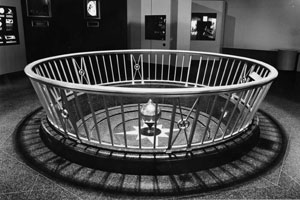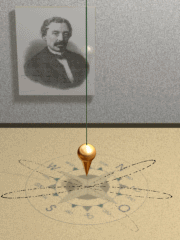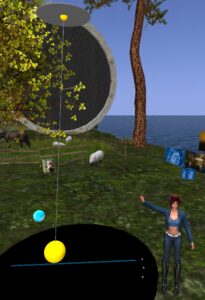

When I was a kid my Dad took me to the California Academy of Sciences in San Francisco. This is a natural history museum and it had the first planetarium in the area. It also had this giant pendulum right in the main lobby. It was this big ball suspended from a wire that went up through the ceiling. To me, it looked like it swung straight across the room and had tremendous energy. It was actually swinging in an arc but that was not obvious to me. What was obvious was that the pendulum was knocking down little pegs. There was a circle of pegs and the pendulum would move over and knock down the next peg. I figured if I stayed there all day it would eventually knock down all the pegs. I thought it was some form of clock. It was not a clock but a free swinging pendulum. What I did not realize was the pendulum was not so much moving around in a circle but that the rotation of the earth was making it look like the pendulum moved around the circle. I was not aware at the time but I was observing one of the first laboratory experiments that demonstrated the earth rotates.
The creator of the pendulum experiment was Léon Foucault (1819 – 1868), who was a French physicist. He is credited with a number of discoveries and one of them was demonstrating that the earth rotates. He did this first with the pendulum and later by the use of a gyroscope. Foucault is credited with inventing the gyroscope
 If you place a Foucault pendulum at the North or South pole, the earth will actually rotate under the pendulum making a full circle in 24 hours. Conversely, a Foucault pendulum on the equator will never change position as the rotational forces are balanced. In-between the poles and the equator, the pendulum takes longer than 24 hours to complete an apparent rotation. This is due to the fact that the earth is actually not turning under the pendulum in San Francisco in the same way as it is at the poles. The centrifugal forces of the earth’s rotation, called the Coriolis force, create an “apparent deflection of moving objects when they are viewed from a rotating frame of reference, and its strength varies with latitude. Freely moving objects on the surface of the Earth experience a Coriolis force, and appear to veer to the right in the northern hemisphere, and to the left in the southern. Over time, this continual veering-off-course causes the swing of the pendulum bob to gradually precess, or rotate.” (KQED).
If you place a Foucault pendulum at the North or South pole, the earth will actually rotate under the pendulum making a full circle in 24 hours. Conversely, a Foucault pendulum on the equator will never change position as the rotational forces are balanced. In-between the poles and the equator, the pendulum takes longer than 24 hours to complete an apparent rotation. This is due to the fact that the earth is actually not turning under the pendulum in San Francisco in the same way as it is at the poles. The centrifugal forces of the earth’s rotation, called the Coriolis force, create an “apparent deflection of moving objects when they are viewed from a rotating frame of reference, and its strength varies with latitude. Freely moving objects on the surface of the Earth experience a Coriolis force, and appear to veer to the right in the northern hemisphere, and to the left in the southern. Over time, this continual veering-off-course causes the swing of the pendulum bob to gradually precess, or rotate.” (KQED).
There is simulation of a Foucault pendulum available for free at the Second Life Marketplace. It is a simulation so the virtual world is not rotating but the animation shows how the real thing works. I have set one up on the Science Circle island. The link is below.

References
- California Academy of Sciences, Wikipedia.
- A Swingin’ History: Cal Academy’s Foucault Pendulum, KQED, 2008.
- Foucault Pendulum, Wikipedia.
- Léon Foucault, Wikipedia
- The Foucault’s pendulum, A report by the students of the college Sainte Elisabeth from Paris.
- Foucault and the rotation of the Earth, JoëL Sommeria, Comptes Rendus Physique, October 2017, 18(9-10).
- Coriolis Force, Wikipedia
- Fourmilab Foucault Pendulum, Second Life Marketplace.
- Get your own pendulum at the Marketplace.
- More information at github.com.
- Foucault pendulum at the Science Circle. You will need to click on this link twice as the first time takes you to the main landing location.
- For a surreal reading experience, I recommend Foucault’s Pendulum by Umberto Eco.
Credits
- Photo credit: Foucault pendulum at the California Academy of Sciences, KQED, 2008.
- Animated GIF: Artistic rendition (highly exaggerated) of a Foucault pendulum showing that the Earth is not stationary, but rotates.
 |
| Visits: 149 |
